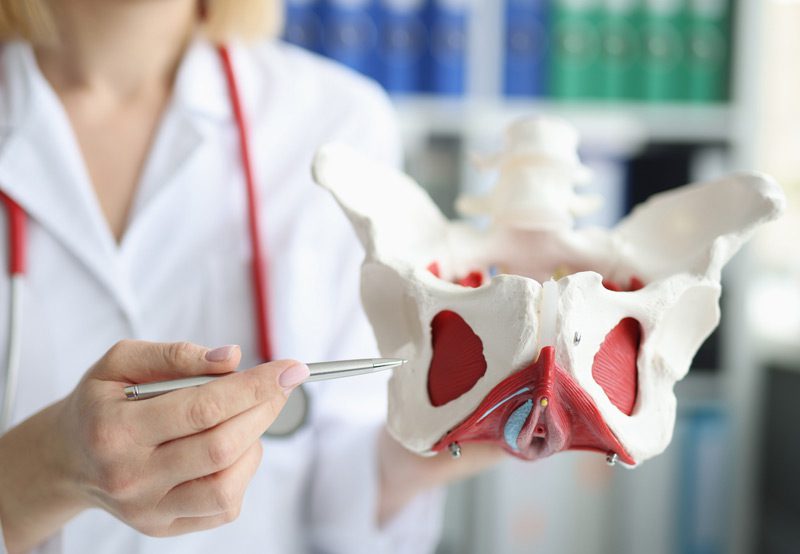

Vulvodynia is a chronic pain condition affecting the vulva, the external genital area. The pain can occur spontaneously or be triggered by activities such as sexual intercourse, sitting for long periods, or wearing tight clothing. It can vary in intensity and may present as burning, stinging, irritation, or rawness.
Vulvodynia can be localized (affecting a specific area) or generalized (affecting the entire vulva) and often has no clear underlying cause, although several contributing factors may be involved. This condition can significantly impact a person’s quality of life, causing distress, discomfort, and emotional difficulties.
Causes of Vulvodynia
Factors that can contribute to vulvodynia include:
- Nerve Injury or Irritation: Damage or irritation to the nerves in the vulvar area, often resulting from trauma or surgery, can contribute to chronic pain.
- Infections: Previous infections, particularly yeast infections, can lead to ongoing irritation or sensitivity in the vulva, contributing to vulvodynia.
- Inflammatory Conditions: Conditions such as vulvar vestibulitis or lichen sclerosus can cause inflammation in the vulva, leading to chronic pain.
- Hormonal Changes: Fluctuations in hormones, especially during pregnancy, menopause, or post-childbirth, may contribute to vulvodynia.
- Pelvic Floor Dysfunction: Tension or abnormal muscle activity in the pelvic floor muscles may cause pain in the vulvar area.
- Genetic Factors: Some individuals may have a genetic predisposition to vulvodynia, making them more susceptible to nerve pain and sensitivity.
- Allergies or Sensitivities: Sensitivity to soaps, lotions, or other products applied to the genital area may result in irritation or inflammation, leading to pain.

Diagnosis
A healthcare provider may diagnose vulvodynia through:
- Symptom History: A detailed discussion of pain characteristics, triggers, and any previous treatments or medical history.
- Pelvic Exam: A physical examination to assess the vulva for signs of inflammation, infection, or other conditions that may cause pain.
- Pain Mapping: A test where a cotton swab is gently applied to different areas of the vulva to identify the specific locations of pain or sensitivity.
- Cultures or Tests for Infections: Ruling out infections like yeast, bacterial vaginosis, or sexually transmitted infections (STIs) through lab tests.
- Biopsy: In some cases, a small tissue sample may be taken to rule out other conditions, such as skin disorders or infections.
- Pelvic Floor Evaluation: An assessment of the pelvic floor muscles to check for dysfunction or abnormal tension.
Treatment Options
Techniques for managing vulvodynia may include:
- Medications: Topical anesthetics, oral pain relievers, or nerve-blocking medications may help manage pain.
- Pelvic Floor Physical Therapy: Therapy to release pelvic floor muscle tension, improve muscle strength, and alleviate discomfort caused by muscle dysfunction.
- Injections: A nerve block can disrupt pain signals in the nerves that carry signals between the spinal cord and vulva. Botox injections can provide relief by relaxing pelvic floor muscles.
- Biofeedback: A technique to help patients become more aware of and control pelvic floor muscle activity, reducing muscle tension and pain.
- Topical Steroids: Creams or ointments to reduce inflammation or irritation caused by conditions like vulvar vestibulitis or lichen sclerosus.
- Hormonal Therapy: Hormonal treatments, including local estrogen therapy, may be recommended for individuals experiencing vulvodynia due to menopause or other hormonal imbalances.
- Trigger Avoidance: Identifying and avoiding irritants such as soaps, scented products, or tight clothing that may exacerbate symptoms.
- Surgical Intervention: In severe cases, surgery to remove affected tissue or nerve deactivation may be considered for individuals who do not respond to other treatments.
Next Steps
If you experience chronic vulvar pain, consult with your healthcare provider for a comprehensive evaluation. With the right diagnosis and treatment plan, vulvodynia can be managed effectively. A combination of medications, therapy, and lifestyle adjustments can help alleviate pain.
